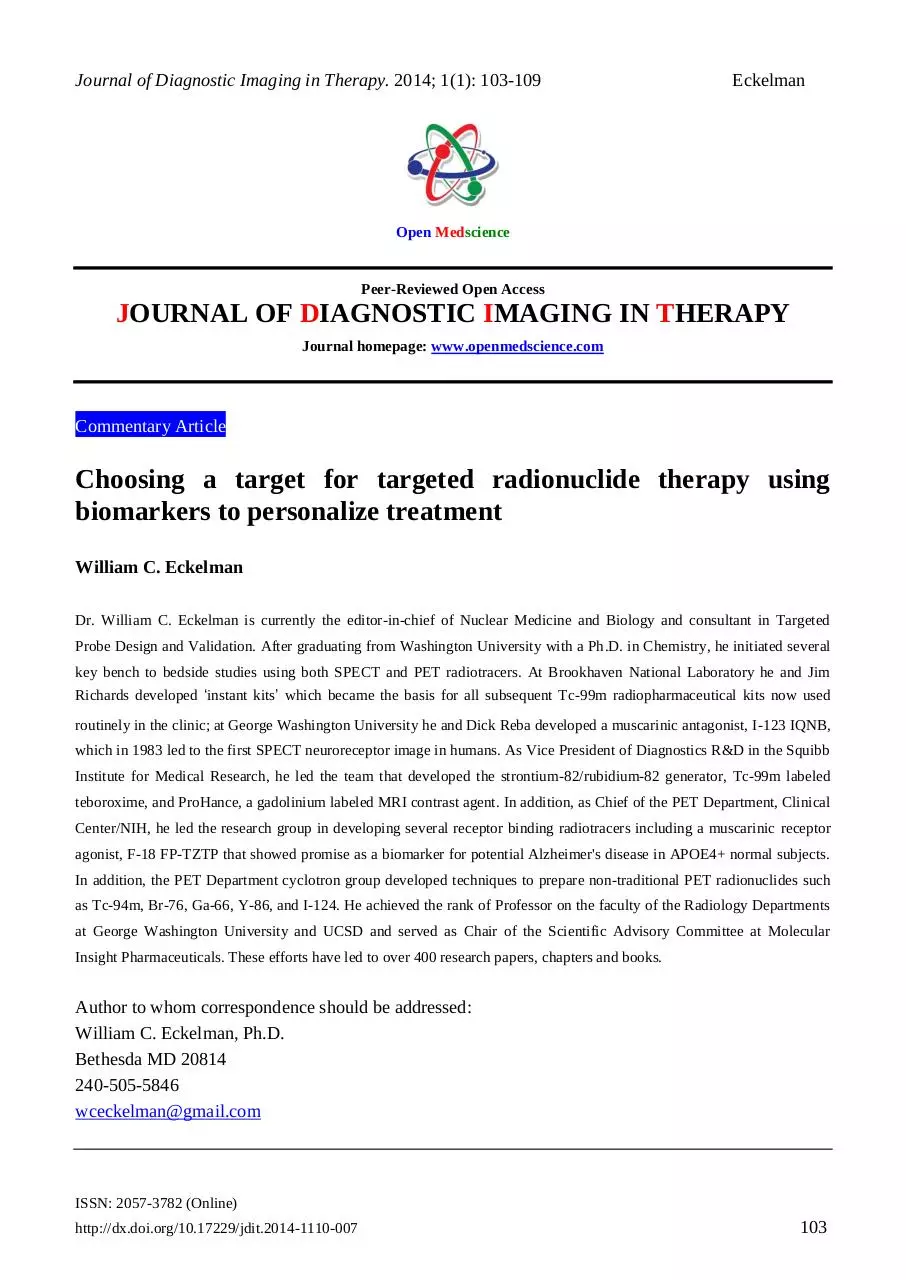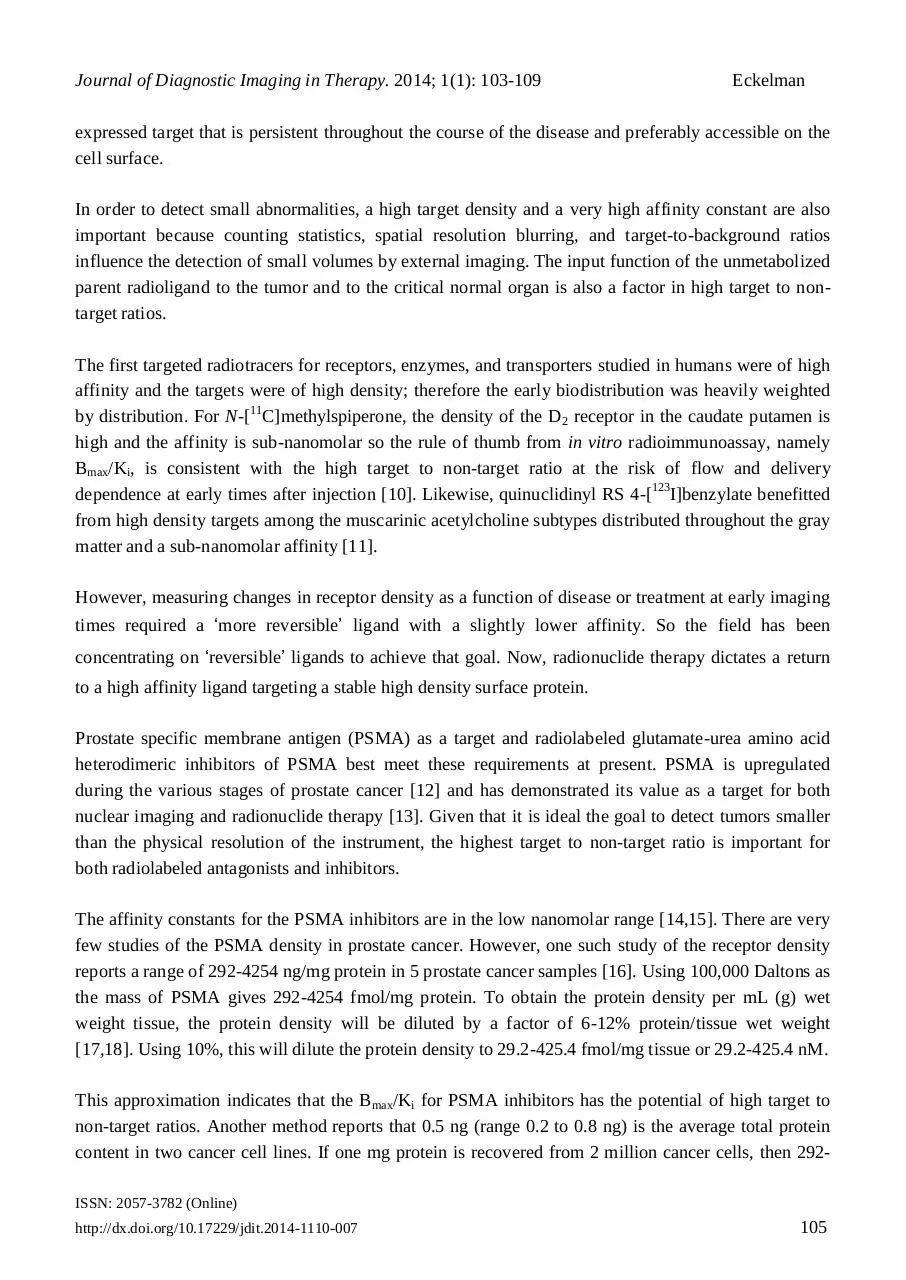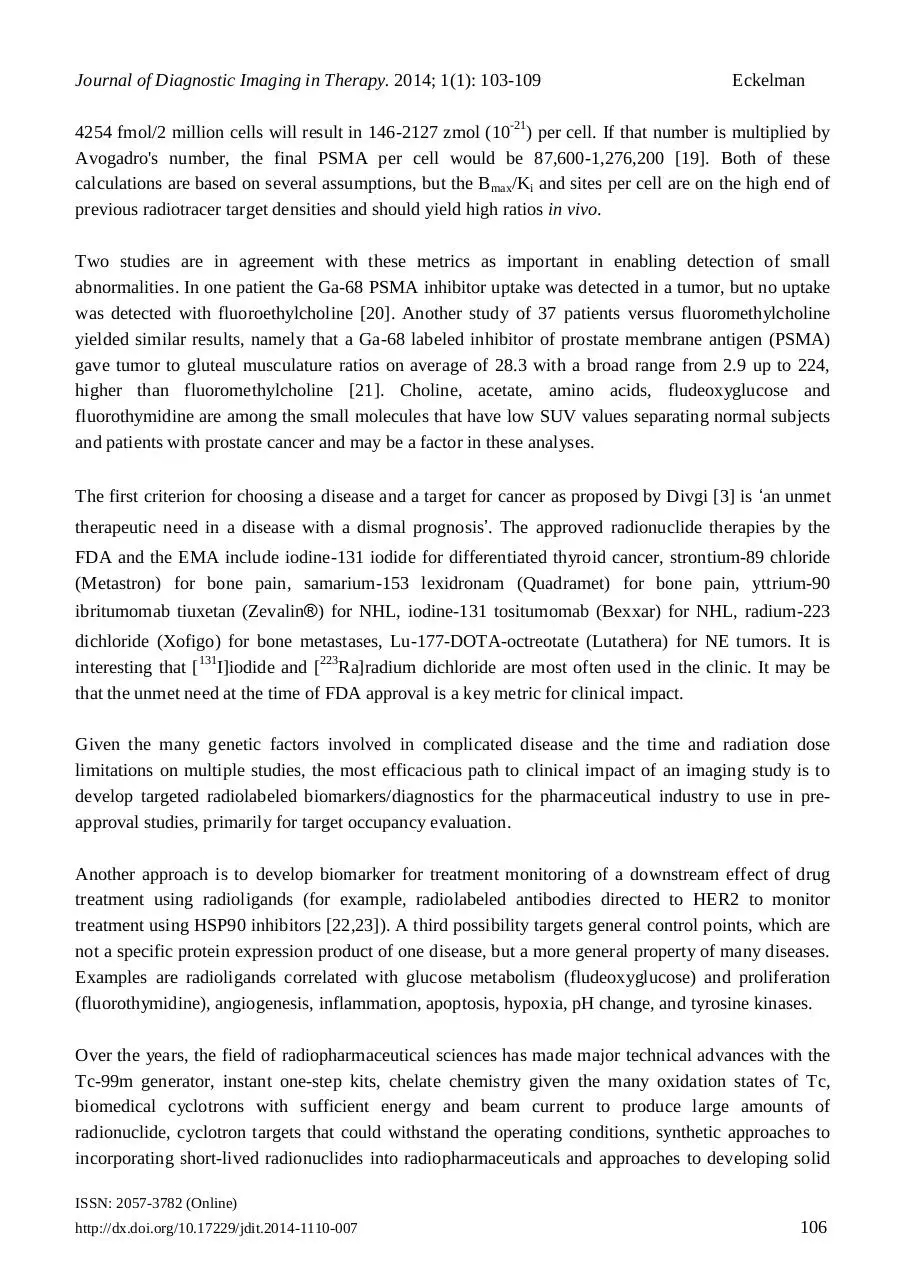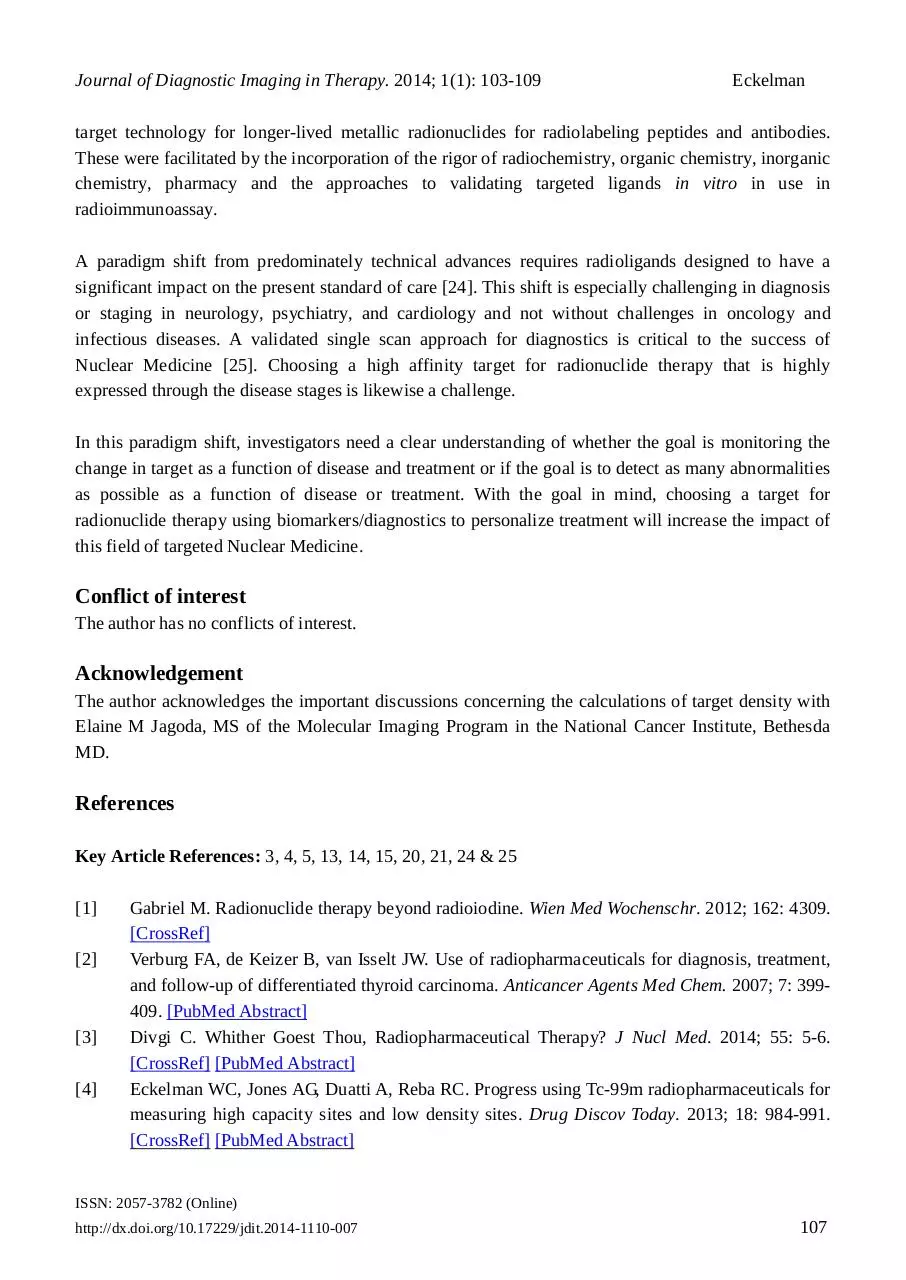JDIT 2014 1110 007 (PDF)
File information
Title:
Author: Sean
This PDF 1.3 document has been generated by Microsoft® Word 2010 / http://www.convertapi.com, and has been sent on pdf-archive.com on 30/05/2017 at 00:32, from IP address 90.218.x.x.
The current document download page has been viewed 347 times.
File size: 145.71 KB (7 pages).
Privacy: public file





File preview
Journal of Diagnostic Imaging in Therapy. 2014; 1(1): 103-109
Eckelman
Open Medscience
Peer-Reviewed Open Access
JOURNAL OF DIAGNOSTIC IMAGING IN THERAPY
Journal homepage: www.openmedscience.com
Commentary Article
Choosing a target for targeted radionuclide therapy using
biomarkers to personalize treatment
William C. Eckelman
Dr. William C. Eckelman is currently the editor-in-chief of Nuclear Medicine and Biology and consultant in Targeted
Probe Design and Validation. After graduating from Washington University with a Ph.D. in Chemistry, he initiated several
key bench to bedside studies using both SPECT and PET radiotracers. At Brookhaven National Laboratory he and Jim
Richards developed ‘instant kits’ which became the basis for all subsequent Tc-99m radiopharmaceutical kits now used
routinely in the clinic; at George Washington University he and Dick Reba developed a muscarinic antagonist, I-123 IQNB,
which in 1983 led to the first SPECT neuroreceptor image in humans. As Vice President of Diagnostics R&D in the Squibb
Institute for Medical Research, he led the team that developed the strontium-82/rubidium-82 generator, Tc-99m labeled
teboroxime, and ProHance, a gadolinium labeled MRI contrast agent. In addition, as Chief of the PET Department, Clinical
Center/NIH, he led the research group in developing several receptor binding radiotracers including a muscarinic receptor
agonist, F-18 FP-TZTP that showed promise as a biomarker for potential Alzheimer's disease in APOE4+ normal subjects.
In addition, the PET Department cyclotron group developed techniques to prepare non-traditional PET radionuclides such
as Tc-94m, Br-76, Ga-66, Y-86, and I-124. He achieved the rank of Professor on the faculty of the Radiology Departments
at George Washington University and UCSD and served as Chair of the Scientific Advisory Committee at Molecular
Insight Pharmaceuticals. These efforts have led to over 400 research papers, chapters and books.
Author to whom correspondence should be addressed:
William C. Eckelman, Ph.D.
Bethesda MD 20814
240-505-5846
wceckelman@gmail.com
ISSN: 2057-3782 (Online)
http://dx.doi.org/10.17229/jdit.2014-1110-007
103
Journal of Diagnostic Imaging in Therapy. 2014; 1(1): 103-109
Eckelman
Commentary
Keywords: radionuclide therapy, phenotype screening, molecular target screening, biomarkers
Although targeted radionuclide therapy is perhaps the greatest opportunity to affect patient care, it has
not been the major focus of Nuclear Medicine research in spite of the unparalleled early success of
[131I]iodide in treating thyroid abnormalities [1,2]. But this seems to be changing slowly [3].
Diagnostic Nuclear Medicine, on the other hand, is still primarily dependent on those
radiopharmaceuticals (radiolabeled with Tc-99m) that monitor high capacity sites, e.g., for myocardial
and cerebral blood flow, glomerular filtration, phagocytosis, hepatocyte clearance, and bone adsorption
for staging disease or the effect of treatment [4].
The pharmaceutical industry has a similar situation in that drugs were based primarily on phenotypic
screening in the pre-genomic era and molecular targeted screening in the post-genomic era. Phenotypic
screening uses a model of the disease and using high throughput screening, chooses the most effective
drug in that model as the lead candidate. The molecular target does not need to be known and in fact,
multiple targets and pathways may be involved. The molecular targeting approach uses a single target
chosen from studies of variant genes [5]. An example of phenotypic screening in radiopharmaceuticals
would be evaluating various Tc-99m chelates as ideal tracers of glomerular filtration in animal models
of renal function. An example of a targeted molecular probe is radiolabeled meta-iodobenzyl guanidine
(MIBG).
Based on the various approaches to linking genetic variants to specific diseases, it is clear that the
number of genetic variants for complex diseases is most often large. For example, genome-wide
association meta-analyses has confirmed the involvement of multiple variants in prostate cancer, breast
cancer, diabetes and schizophrenia [6]. To further complicate the choice of a single target, there are
several post-genomic alterations in the process of developing a potential drug target. The various
‘omics’ such as transcriptomics, epigenetics, miRNA, proteomics, phosphoproteomics and
metabolomics introduce further variants to the molecule target for external imaging [7].
As a result, next-generation genomic sequencers, not nuclear imaging in vivo, are best for identifying
and monitoring variant genes involved in a particular complex disease in order to personalize medicine
for the sampled tumor [8]. Choosing a target for a drug or an imaging agent is a more difficult
challenge for targeted imaging. Nuclear Imaging, especially, is limited to one or two targets given
patient tolerance and absorbed radiation dose.
Why targeted radionuclide therapy for oncology?
At present, there may be applications for certain infections [9], but not in either neurology, psychiatry
or cardiology. One advantage of radionuclide therapy over targeted chemotherapy is the target does not
have to be a key step in the biochemical pathway of the tumor. Rather, the criteria are a highly
ISSN: 2057-3782 (Online)
http://dx.doi.org/10.17229/jdit.2014-1110-007
104
Journal of Diagnostic Imaging in Therapy. 2014; 1(1): 103-109
Eckelman
expressed target that is persistent throughout the course of the disease and preferably accessible on the
cell surface.
In order to detect small abnormalities, a high target density and a very high affinity constant are also
important because counting statistics, spatial resolution blurring, and target-to-background ratios
influence the detection of small volumes by external imaging. The input function of the unmetabolized
parent radioligand to the tumor and to the critical normal organ is also a factor in high target to nontarget ratios.
The first targeted radiotracers for receptors, enzymes, and transporters studied in humans were of high
affinity and the targets were of high density; therefore the early biodistribution was heavily weighted
by distribution. For N-[11C]methylspiperone, the density of the D2 receptor in the caudate putamen is
high and the affinity is sub-nanomolar so the rule of thumb from in vitro radioimmunoassay, namely
Bmax/Ki, is consistent with the high target to non-target ratio at the risk of flow and delivery
dependence at early times after injection [10]. Likewise, quinuclidinyl RS 4-[123I]benzylate benefitted
from high density targets among the muscarinic acetylcholine subtypes distributed throughout the gray
matter and a sub-nanomolar affinity [11].
However, measuring changes in receptor density as a function of disease or treatment at early imaging
times required a ‘more reversible’ ligand with a slightly lower affinity. So the field has been
concentrating on ‘reversible’ ligands to achieve that goal. Now, radionuclide therapy dictates a return
to a high affinity ligand targeting a stable high density surface protein.
Prostate specific membrane antigen (PSMA) as a target and radiolabeled glutamate-urea amino acid
heterodimeric inhibitors of PSMA best meet these requirements at present. PSMA is upregulated
during the various stages of prostate cancer [12] and has demonstrated its value as a target for both
nuclear imaging and radionuclide therapy [13]. Given that it is ideal the goal to detect tumors smaller
than the physical resolution of the instrument, the highest target to non-target ratio is important for
both radiolabeled antagonists and inhibitors.
The affinity constants for the PSMA inhibitors are in the low nanomolar range [14,15]. There are very
few studies of the PSMA density in prostate cancer. However, one such study of the receptor density
reports a range of 292-4254 ng/mg protein in 5 prostate cancer samples [16]. Using 100,000 Daltons as
the mass of PSMA gives 292-4254 fmol/mg protein. To obtain the protein density per mL (g) wet
weight tissue, the protein density will be diluted by a factor of 6-12% protein/tissue wet weight
[17,18]. Using 10%, this will dilute the protein density to 29.2-425.4 fmol/mg tissue or 29.2-425.4 nM.
This approximation indicates that the Bmax/Ki for PSMA inhibitors has the potential of high target to
non-target ratios. Another method reports that 0.5 ng (range 0.2 to 0.8 ng) is the average total protein
content in two cancer cell lines. If one mg protein is recovered from 2 million cancer cells, then 292ISSN: 2057-3782 (Online)
http://dx.doi.org/10.17229/jdit.2014-1110-007
105
Journal of Diagnostic Imaging in Therapy. 2014; 1(1): 103-109
Eckelman
4254 fmol/2 million cells will result in 146-2127 zmol (10-21) per cell. If that number is multiplied by
Avogadro's number, the final PSMA per cell would be 87,600-1,276,200 [19]. Both of these
calculations are based on several assumptions, but the Bmax/Ki and sites per cell are on the high end of
previous radiotracer target densities and should yield high ratios in vivo.
Two studies are in agreement with these metrics as important in enabling detection of small
abnormalities. In one patient the Ga-68 PSMA inhibitor uptake was detected in a tumor, but no uptake
was detected with fluoroethylcholine [20]. Another study of 37 patients versus fluoromethylcholine
yielded similar results, namely that a Ga-68 labeled inhibitor of prostate membrane antigen (PSMA)
gave tumor to gluteal musculature ratios on average of 28.3 with a broad range from 2.9 up to 224,
higher than fluoromethylcholine [21]. Choline, acetate, amino acids, fludeoxyglucose and
fluorothymidine are among the small molecules that have low SUV values separating normal subjects
and patients with prostate cancer and may be a factor in these analyses.
The first criterion for choosing a disease and a target for cancer as proposed by Divgi [3] is ‘an unmet
therapeutic need in a disease with a dismal prognosis’. The approved radionuclide therapies by the
FDA and the EMA include iodine-131 iodide for differentiated thyroid cancer, strontium-89 chloride
(Metastron) for bone pain, samarium-153 lexidronam (Quadramet) for bone pain, yttrium-90
ibritumomab tiuxetan (Zevalin®) for NHL, iodine-131 tositumomab (Bexxar) for NHL, radium-223
dichloride (Xofigo) for bone metastases, Lu-177-DOTA-octreotate (Lutathera) for NE tumors. It is
interesting that [131I]iodide and [223Ra]radium dichloride are most often used in the clinic. It may be
that the unmet need at the time of FDA approval is a key metric for clinical impact.
Given the many genetic factors involved in complicated disease and the time and radiation dose
limitations on multiple studies, the most efficacious path to clinical impact of an imaging study is to
develop targeted radiolabeled biomarkers/diagnostics for the pharmaceutical industry to use in preapproval studies, primarily for target occupancy evaluation.
Another approach is to develop biomarker for treatment monitoring of a downstream effect of drug
treatment using radioligands (for example, radiolabeled antibodies directed to HER2 to monitor
treatment using HSP90 inhibitors [22,23]). A third possibility targets general control points, which are
not a specific protein expression product of one disease, but a more general property of many diseases.
Examples are radioligands correlated with glucose metabolism (fludeoxyglucose) and proliferation
(fluorothymidine), angiogenesis, inflammation, apoptosis, hypoxia, pH change, and tyrosine kinases.
Over the years, the field of radiopharmaceutical sciences has made major technical advances with the
Tc-99m generator, instant one-step kits, chelate chemistry given the many oxidation states of Tc,
biomedical cyclotrons with sufficient energy and beam current to produce large amounts of
radionuclide, cyclotron targets that could withstand the operating conditions, synthetic approaches to
incorporating short-lived radionuclides into radiopharmaceuticals and approaches to developing solid
ISSN: 2057-3782 (Online)
http://dx.doi.org/10.17229/jdit.2014-1110-007
106
Journal of Diagnostic Imaging in Therapy. 2014; 1(1): 103-109
Eckelman
target technology for longer-lived metallic radionuclides for radiolabeling peptides and antibodies.
These were facilitated by the incorporation of the rigor of radiochemistry, organic chemistry, inorganic
chemistry, pharmacy and the approaches to validating targeted ligands in vitro in use in
radioimmunoassay.
A paradigm shift from predominately technical advances requires radioligands designed to have a
significant impact on the present standard of care [24]. This shift is especially challenging in diagnosis
or staging in neurology, psychiatry, and cardiology and not without challenges in oncology and
infectious diseases. A validated single scan approach for diagnostics is critical to the success of
Nuclear Medicine [25]. Choosing a high affinity target for radionuclide therapy that is highly
expressed through the disease stages is likewise a challenge.
In this paradigm shift, investigators need a clear understanding of whether the goal is monitoring the
change in target as a function of disease and treatment or if the goal is to detect as many abnormalities
as possible as a function of disease or treatment. With the goal in mind, choosing a target for
radionuclide therapy using biomarkers/diagnostics to personalize treatment will increase the impact of
this field of targeted Nuclear Medicine.
Conflict of interest
The author has no conflicts of interest.
Acknowledgement
The author acknowledges the important discussions concerning the calculations of target density with
Elaine M Jagoda, MS of the Molecular Imaging Program in the National Cancer Institute, Bethesda
MD.
References
Key Article References: 3, 4, 5, 13, 14, 15, 20, 21, 24 & 25
[1]
[2]
[3]
[4]
Gabriel M. Radionuclide therapy beyond radioiodine. Wien Med Wochenschr. 2012; 162: 4309.
[CrossRef]
Verburg FA, de Keizer B, van Isselt JW. Use of radiopharmaceuticals for diagnosis, treatment,
and follow-up of differentiated thyroid carcinoma. Anticancer Agents Med Chem. 2007; 7: 399409. [PubMed Abstract]
Divgi C. Whither Goest Thou, Radiopharmaceutical Therapy? J Nucl Med. 2014; 55: 5-6.
[CrossRef] [PubMed Abstract]
Eckelman WC, Jones AG, Duatti A, Reba RC. Progress using Tc-99m radiopharmaceuticals for
measuring high capacity sites and low density sites. Drug Discov Today. 2013; 18: 984-991.
[CrossRef] [PubMed Abstract]
ISSN: 2057-3782 (Online)
http://dx.doi.org/10.17229/jdit.2014-1110-007
107
Journal of Diagnostic Imaging in Therapy. 2014; 1(1): 103-109
[5]
[6]
[7]
[8]
[9]
[10]
[11]
[12]
[13]
[14]
[15]
[16]
[17]
[18]
[19]
Eckelman
Zheng W, Thorne N, McKew JC. Phenotypic screens as a renewed approach for drug discovery.
Drug Discov Today. 2013; 18: 1067-1073. [CrossRef] [PubMed Abstract]
Visscher PM, Brown MA, McCarthy MI, Yang J. Five years of GWAS discovery. Am J Hum
Genet. 2013; 90: 7-24. [CrossRef] [PubMed Abstract]
Berg EL. Systems biology in drug discovery and development. Drug Discov Today. 2014; 19:
113-125. [CrossRef] [PubMed Abstract]
Collins FS, Hamburg MA. First FDA authorization for next-generation sequencer. N Engl J
Med. 2013; 369: 2369-2371. [CrossRef] [PubMed Abstract]
Tsukrov D, Dadachova E. The potential of radioimmunotherapy as a new hope for HIV
patients. Expert Rev Clin Immunol. 2014; 10: 553-555. [CrossRef] [PubMed Abstract]
Wong DF, Gjedde A, Wagner HN Jr. Quantification of neuroreceptors in the living human
brain. I. Irreversible binding of ligands. J Cereb Blood Flow Metab. 1986; 6: 137-146.
[CrossRef] [PubMed Abstract]
Eckelman WC. Radiolabeled muscarinic radioligands for in vivo studies. Nucl Med Biol. 2001;
28: 485-491. [CrossRef] [PubMed Abstract]
Ghosh A, Heston WD. Tumor target prostate specific membrane antigen (PSMA) and its
regulation in prostate cancer. J Cell Biochem. 2004; 9: 528-539. [CrossRef]
Zechmann CM, Afshar-Oromieh A, Armor T, Stubbs JB, Mier W, Hadaschik B, et al. Radiation
dosimetry and first therapy results with a (124)I/ (131)I-labeled small molecule (MIP-1095)
targeting PSMA for prostate cancer therapy. Eur J Nucl Med Mol Imaging. 2014; 41: 12801292. [PubMed Abstract] [PMC Free Article]
Hillier SM, Kern AM, Maresca KP, Marquis JC, Eckelman WC, Joyal JL, et al. 123I-MIP-1072,
a small-molecule inhibitor of prostate-specific membrane antigen, is effective at monitoring
tumor response to taxane therapy. J Nucl Med. 2011; 52: 1087-1093. [CrossRef]
[PubMed Abstract]
Foss CA, Mease RC, Cho SY, Kim HJ, Pomper MG. GCPII imaging and cancer. Curr Med
Chem. 2012; 19: 1346-1359. [PubMed Abstract] [PMC Free Article]
Sokoloff RL, Norton KC, Gasior CL, Marker KM, Grauer LS. A dual-monoclonal sandwich
assay for prostate-specific membrane antigen: levels in tissues, seminal fluid and urine.
Prostate. 2000; 43: 150-157. [CrossRef] [PubMed Abstract]
Largent BL, Gundlack AL, Snyder SH. Pharmacological and autoradiographic discrimination
of sigma and phencyclidine receptor binding sites in brain with (+)-[3H]SKF 10,047, (+)-[3H]3-[3-hydroxyphenyl]-N-(1-propyl)piperidine and [3H]-1-[1-(2-thienyl)cyclohexyl]piperidine. J
Pharmacol Exp Ther. 1986; 238: 739-748. [PubMed Abstract]
Banay-Schwartz M, Kenessey A, DeGuzman T, Lajtha A, Paikovits. Protein content of various
regions of rat brain and adult and aging human brain. Age. 1992; 15: 51-54. [CrossRef]
Dolfi SC, Chan LLi-Ying, Qiu J, Tedeschi PM, Bertino JR, Hirshfield KM, et al. The metabolic
demands of cancer cells are coupled to their size and protein synthesis rates. Cancer Metab.
2013; 1: 20-37. [CrossRef]
ISSN: 2057-3782 (Online)
http://dx.doi.org/10.17229/jdit.2014-1110-007
108
Journal of Diagnostic Imaging in Therapy. 2014; 1(1): 103-109
[20]
[21]
[22]
[23]
[24]
[25]
Eckelman
Afshar-Oromieh A, Haberkorn U, Eder M, Eisenhut M, Zechmann CM. [68Ga]Gallium-labelled
PSMA ligand as superior PET tracer for the diagnosis of prostate cancer: comparison with 18FFECH. Eur J Nucl Med Mol Imaging. 2012; 39: 1085-1086. [CrossRef] [PubMed Abstract]
Afshar-Oromieh A, Zechmann CM, Malcher A, et al. Comparison of PET imaging with a
(68)Ga-labelled PSMA ligand and (18)F-choline-based PET/CT for the diagnosis of recurrent
prostate cancer. Eur J Nucl Med Mol Imaging. 2014; 41: 11-20. [PubMed Abstract]
[PMC Free Article]
Smith-Jones Solit DB, Akhurst T, Afroze F, Rosen N, Larson SM. Imaging the pharmacodynamics of HER2 degradation in response to HSP90 inhibitors. Nat Biotechnol.2004; 22:
701-706. [PubMed Abstract]
Gaykema SB, Schröder CP, Vitfell-Rasmussen J, Chua S, Oude Munnink TH, Brouwers AH, et
al. 89Zr-trastuzumab and 89Zr-bevacizumab PET to evaluate the effect of the HSP90 inhibitor
NVP-AUY922 in metastatic breast cancer patients. Clin Cancer Res. 2014; 20: 3945-3954.
[CrossRef] [PubMed Abstract]
Eckelman WC, Lau CY, Neumann RD. Perspective, the one most responsive to change. Nucl
Med Biol. 2014; 41: 297-298. [CrossRef] [PubMed Abstract]
Galli G, Indovina L, Calcagni ML, Mansi L, Giordano A. The quantification with FDG as seen
by a physician. Nucl Med Biol. 2013; 40: 720-730. [CrossRef] [PubMed Abstract]
Citation: Eckelman WC. Choosing a target for targeted radionuclide therapy using biomarkers to
personalize treatment. Journal of Diagnostic Imaging in Therapy. 2014; 1(1): 103-109.
http://dx.doi.org/10.17229/jdit.2014-1110-007
Copyright: © 2014 Eckelman WC. This is an open-access article distributed under the terms of the
Creative Commons Attribution License, which permits unrestricted use, distribution, and reproduction
in any medium, provided the original author and source are cited.
Received: 04 November 2014 | Revised: 06 November 2014 | Accepted: 10 November 2014
Published Online 10 November 2014 (http://www.openmedscience.com)
ISSN: 2057-3782 (Online)
http://dx.doi.org/10.17229/jdit.2014-1110-007
109
Download JDIT-2014-1110-007
JDIT-2014-1110-007.pdf (PDF, 145.71 KB)
Download PDF
Share this file on social networks
Link to this page
Permanent link
Use the permanent link to the download page to share your document on Facebook, Twitter, LinkedIn, or directly with a contact by e-Mail, Messenger, Whatsapp, Line..
Short link
Use the short link to share your document on Twitter or by text message (SMS)
HTML Code
Copy the following HTML code to share your document on a Website or Blog
QR Code to this page

This file has been shared publicly by a user of PDF Archive.
Document ID: 0000603697.